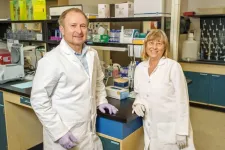(Press-News.org) Washington, D.C. – Investigators in Israel and Italy have developed a model of the blood-brain barrier, studies of which may lead to prevention of meningitis in newborns. The research is published in Microbiology Spectrum, a journal of the American Society for Microbiology.
The investigators further developed a platform called organs-on-a-chip—invented during the 2000s—to construct the model. These devices, which are modeled after microchips, contain tiny channels lined with living human organ cells and others with human blood vessel cells. In this case, the researchers grew human neuronal and glial cells within the chip, atop cells from human vasculature, the latter separated from the other cell types by a membrane, as they are in humans and other animals.
The investigators then tested the chips by infecting each with one of several meningitis causing strains of E. coli that infect newborns. They had isolated these strains from cases of newborn meningitis, an infection that cannot be prevented by the standard vaccination against meningitis. The meningitis strains caused the neurons growing in the chips to degenerate, and ultimately, to die.
The overarching goal of developing the organ-on-a-chip was to hasten drug development for the treatment of newborn meningitis, said corresponding author Ben M. Maoz, Ph.D., Department of Biomedical Engineering, Sagol School of Neuroscience, and Sagol Center for Regenerative Medicine, Tel Aviv University, Tel Aviv, Israel. Newborn meningitis infects around 1% of all newborns, with a mortality rate of about 50% in developing countries, and 8-12.5% in industrialized countries. “Those who recover are prone to developing neurodegenerative disease,” Maoz said.
However, between 60 and 90 % of experimental drugs that work when tested for safety and efficacy in animals fail when tested in humans, which is not surprising since animal models are rough approximations of human physiology, at best. Testing drugs on organs-on-a-chip will be far more accurate at predicting efficacy and safety in humans, said Maoz. It will also be much quicker and less expensive than testing in animals, providing answers in hours rather than weeks, months or even years.
The organ-on-a-chip can also be used to determine how other pathologies affect the blood-brain barrier, said Maoz. Maoz and his collaborators currently are investigating how Parkinson’s disease and certain drugs such as methamphetamine affect the chip to determine how they might affect the blood-brain barrier. They have found that crystal meth causes neurotoxicity by opening the blood-brain barrier, allowing toxic materials from blood to enter the brain, said Maoz. In the case of Parkinson’s disease, “we see vascular dysfunction which causes higher permeability.”
###
The American Society for Microbiology is one of the largest professional societies dedicated to the life sciences and is composed of 30,000 scientists and health practitioners. ASM's mission is to promote and advance the microbial sciences.
ASM advances the microbial sciences through conferences, publications, certifications, educational opportunities and advocacy efforts. It enhances laboratory capacity around the globe through training and resources. It provides a network for scientists in academia, industry and clinical settings. Additionally, ASM promotes a deeper understanding of the microbial sciences to diverse audiences.
END
Model blood-brain barrier could improve newborn meningitis treatment
2023-06-22
ELSE PRESS RELEASES FROM THIS DATE:
TTUHSC-TTU research collaboration leads to possible drug targets for Leishmaniasis
2023-06-22
Leishmaniasis is a tropical disease caused by parasites known as Leishmania, which are transmitted to humans and animals through the bites of more than 90 species of sand flies. Considered a neglected tropical disease, leishmaniasis is found in approximately 88 countries primarily located in South and Central America, the Middle East and western Asia. As many as 1 million new cases are diagnosed each year and more than 350 million people are at risk of infection. Some forms of the disease ...
'Poo transplant' trial provides hope for liver disease patients
2023-06-22
The UK is to launch a clinical trial of a ‘poo transplant’ that researchers believe could treat advanced liver disease and fight antimicrobial resistance.
The trial’s investigators also provide evidence for the first time that a faecal transplant can dramatically improve gut health.
The PROMISE trial is led by King’s College London and funded by a National Institute for Health and Care Research (NIHR) and Medical Research Council (MRC) partnership. It will recruit patients with cirrhosis from across the UK to test whether oral Faecal Microbiota Transplant (FMT) capsules from freeze-dried stool from healthy volunteers reduces the likelihood of getting an ...
The development of an online platform to promote customized self oral healthcare
2023-06-22
Alexandria, VA, USA – A study that introduces a new strategy to promote customized, oral health self-care by using an online platform to connect dental professionals and patients will be presented at the 101st General Session of the IADR, which will be held in conjunction with the 9th Meeting of the Latin American Region and the 12th World Congress on Preventive Dentistry on June 21-24, 2023, in Bogotá, Colombia.
The Interactive Talk presentation, “An Online Platform to Promote Customized Self Oral Healthcare,” will take place on Thursday, ...
Study examines the effect of university closures in Bolivia during COVID-19 pandemic on graduates’ self-confidence
2023-06-22
Alexandria, VA, USA – A study examining the effect of COVID-19 lockdowns on Bolivian dental school graduates will be presented at the 101st General Session of the IADR, which will be held in conjunction with the 9th Meeting of the Latin American Region and the 12th World Congress on Preventive Dentistry on June 21-24, 2023, in Bogotá, Colombia.
The Interactive Talk presentation, “Covid–19 Pandemic Effects on Graduates’ Self Confidence to Execute Dental Clinical Procedures,” will take place on Thursday, June 22, 2023, at 2 p.m. Colombia Time (UTC-05:00) during the “Attitude ...
Genetic mutations blunt immune defences in leukaemia-linked rare bone marrow disorder
2023-06-22
Patients with a rare genetic bone marrow disorder which puts them at increased risk of blood cancers could benefit from a discovery that may lead to new treatments to slow or reverse the disease.
In a new study published in Cell Reports, scientists from the University of Birmingham and University of Warwick have found that affected blood stem cells that are produced in bone marrow produce much fewer immune cells used to fight infection. The mutation in the GATA2 gene in these blood stem cells results in impaired ability to repair ongoing damage to their DNA and puts patients at risk of developing blood cancers. The median age for patients developing Acute Myeloid Leukaemia who ...
New 3D-printing method builds structures with two metals
2023-06-22
PULLMAN, Wash. – Taking a cue from the structural complexity of trees and bones, Washington State University engineers have created a way to 3D-print two types of steel in the same circular layer using two welding machines. The resulting bimetallic material proved 33% to 42% stronger than either metal alone, thanks in part to pressure caused between the metals as they cool together.
The new method uses commonplace, relatively inexpensive tools, so manufacturers and repair shops could use it in the ...
Global analysis on pollinators in cities: Wild bees and butterflies are at particular risk
2023-06-22
Butterflies are being hit hardest by urban growth. Shrinking habitats and food availability are causing their populations to decline. The same applies to many wild bees that fly early in spring. According to a new study by the Martin Luther University Halle-Wittenberg (MLU) and the Chinese Academy of Sciences in "Ecology Letters", pollination has not yet been impacted by this because honeybees, for example, can compensate for the reduction of urban pollinators. The study is the first comprehensive analysis of the subject and includes data from 133 studies. The results underline the importance ...
Lifetime burden of psychological symptoms, disorders, suicide due to cancer in children, adolescents, young adults
2023-06-22
About The Study: This systematic review and meta-analysis including 52 studies found children, adolescent, and young adult patients with cancer experience an increased risk of depression, anxiety, and psychotic disorders after cancer remission compared with siblings and noncancer-matched controls. Timely identification, preventive efforts, and psycho-oncological intervention for psychological comorbidity are recommended.
Authors: Ainsley Ryan Yan Bin Lee, M.B.B.S. (Hons.), and Cyrus Su Hui Ho, Ph.D., of the National University of Singapore, are the corresponding authors.
To access the embargoed study: Visit our For The Media ...
Space travel alters gene expression in white blood cells, weakening our immune system
2023-06-22
Evidence is mounting that astronauts are more susceptible to infections while in space. For example, astronauts on board the International Space Station (ISS) commonly suffer from skin rashes, as well as respiratory and non-respiratory diseases. Astronauts are also known to shed more live virus particles, for example Epstein-Barr virus, varicella-zoster responsible for shingles, herpes-simplex-1 responsible for sores, and cytomegalovirus. These observations suggest that our immune system might be weakened by space travel. But what could cause such an immune deficit?
“Here we show that the expression of many ...
World's biggest study of wildfire smoke impact reveals alarming long-term health impacts
2023-06-22
As North America recovers from some of the worst air quality in decades due to wildfires, one of the largest and most comprehensive studies into the long-term health impact of smoke exposure raises significant concerns about the long-term health impact of the Canadian wildfires.
The study found that a 10 μg/m3 increase of wildfire-related PM2.5 exposure was associated with a 0.4% higher risk of all-cause and nonaccidental mortality, and a 0.5% increase in risk of dying from neoplasms. On June 8, at the peak of the wildfire pollution, ...



